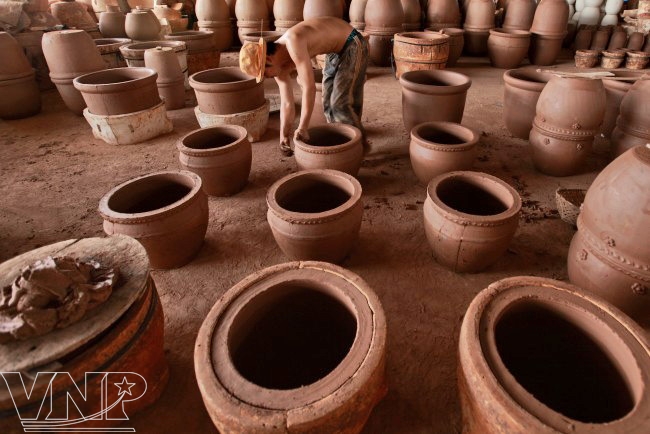Few people know that pottery products in Bien Hoa, Dong Nai Province were famous both at home and abroad from the late 19th century to the early 20th century.
Few people know that pottery products in Bien Hoa, Dong Nai Province were famous both at home and abroad from the late 19th century to the early 20th century. So far, the types of pottery products made in Bien Hoa during that period are still invaluable and rare for those who are keen on collecting ancient pottery.
Located along the basin of the romantic Dong Nai River, Bien Hoa City has been known for the traditional pottery making craft that has existed for about 300 years. Today, the craft is only done in the wards of Buu Long and Tan Van in Tan Hanh and Hoa An Communes where there are about 400 small and large production workshops of families.
Bien Hoa is the place where the Bien Hoa Vocational Training School, the first pottery vocational training school of Indochina, was founded in 1903. In 1913, the school was renamed the Bien Hoa Fine Arts School. In 1923 when the couple, Robert Balick and Mariettee Balick, managed the school, they marked a milestone for Bien Hoa pottery. Working as Head of the School’s Pottery Board, Mariette Balick devised a plan for developing the pottery craft in the area with a focus on producing pottery with different colours, delicate patterns and unique glazes. Then, Mariette Balick and her Vietnamese colleagues created successfully some glazes, such as blue-speckled copper and celadon glaze from natural materials, such as rice straw ash, sand in Da Nang and laterite.

Bien Hoa pottery is made with the mould.
In the early 20th century, Bien Hoa fine art pottery was well-known in both Asia and Europe. In 1925, the pottery products from the Bien Hoa Fine Arts School were displayed at an international exhibition held in Paris and were a huge success. All the pottery products were sold out and the school received many orders from customers. At that exhibition, Bien Hoa pottery was awarded the honorary certificate by the French Government and a golden medal from the exhibition’s organization board. However, not until an international exhibition held in 1933 in Paris, did Bien Hoa Pottery really affirm its position in France and other pottery markets.
Since then, Bien Hoa pottery products were shown in many large exhibitions both at home and abroad, such as Nagoya (Japan – 1937), Hanoi (1938), Sai Gon (1942), Bangkok (Thailand – 1953 and 1955) and PhnomPenh (Cambodia – 1957). This period marked the beginning of the most prosperous development of Bien Hoa pottery.
To explain the reason why Bien Hoa pottery was a favourite in the international market, Vong Khieng, General Secretary of Dong Nai Fine Arts Pottery Association said: “Bien Hoa pottery is beautiful and unique in both patterns and glazes because it is a product with a blend of three pottery types of the Vietnamese, the Chinese and the Cham”. At present, the workshops in Bien Hoa produce two major kinds of pottery, including the fine art and pattern pottery of white clay with the technique of under-glaze carving and directly creating patterns on potter and the pottery of black clay burnt at a high temperature.
We visited Phat Thanh pottery kiln with a total area of nearly 5,000m2 in Tan Van Ward. With 30 potters, the kiln is able of producing about 300 products each day. While taking us to the pottery producing area, artisan Nguyen Huu Tan, the owner of Phat Thanh pottery kiln, said: “It is my only kiln left. There were times we did not have enough pottery products to provide to the market. I have engaged in the craft for nearly 50 years so I always nurture an idea to restore the traditional craft of my ancestors.”
 A big pottery flower vase made in Bien Hoa.
A big pottery flower vase made in Bien Hoa.There are many factors that create distinctive features for Bien Hoa pottery, such as the technique on formulating glazes and the application of glazes and firing. The formulation for glazes decides the colours of products and many of these are a closely guarded secret of each family. The way to adhere the glaze to the products also plays an important role in the process of making pottery. The products will deform while firing if the artisans do not perform well this technique. Once the products are glazed, they are brought to the kiln for firing. This stage decides the success or the failure of the batch of pottery products. Those who take responsibility for this stage must have experience that helps them determine exactly the temperature in the kiln through seeing the flame and adjust the kiln’s temperature as firing schedule.
Bien Hoa pottery products are now diverse in styles, colours, patterns and glazes so they have great value in terms of art and utilization. They are big flower vases, round supports for flower pots and animal statues. Also, Bien Hoa produces bisque terracotta products (red pottery) with simple and natural beauty which are sought after by customers. To meet the increasing demand of customers, the artisans in Bien Hoa have made great efforts to restore the type of pottery with blue-speckled copper glaze.
Although the turnover of the pottery making craft in Bien Hoa has reached about 1 million dollars/year, it is a modest number compared to 10 years ago. To further develop the craft, it needs the efforts and determination of artisans and the support and sound policies of the authorities.
(Source: VNP)





